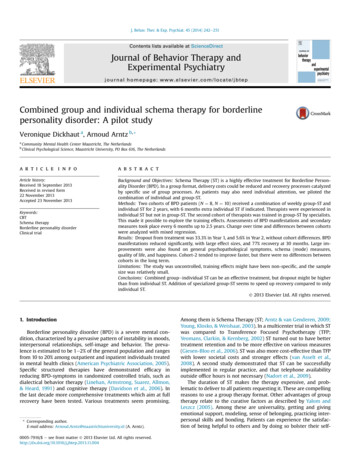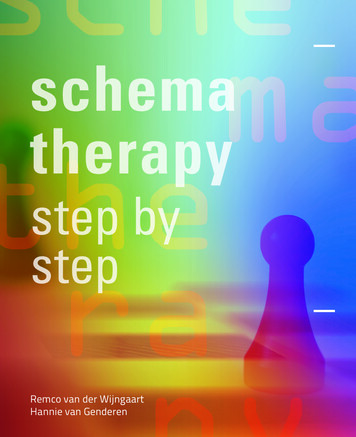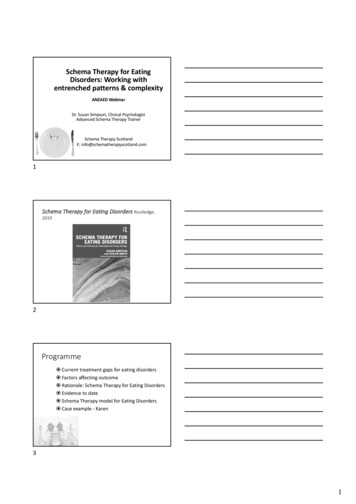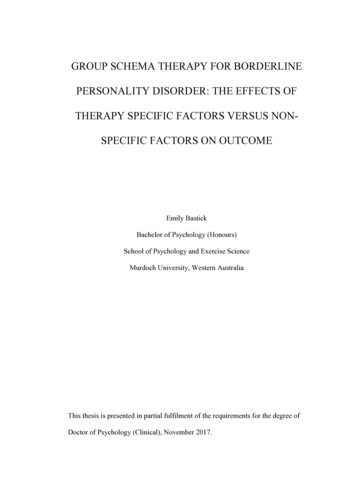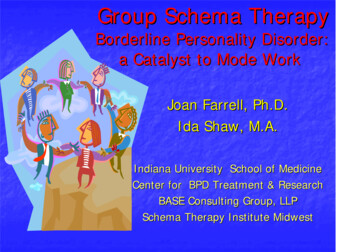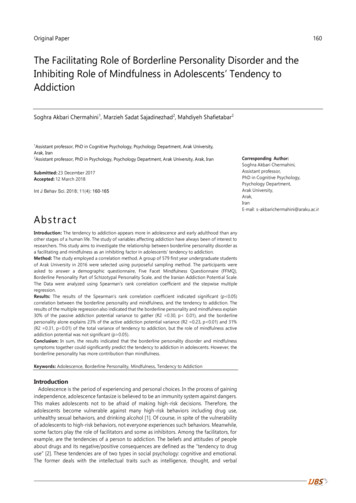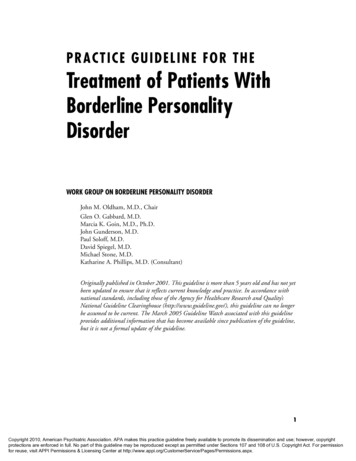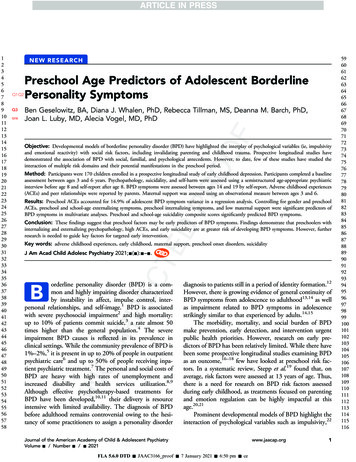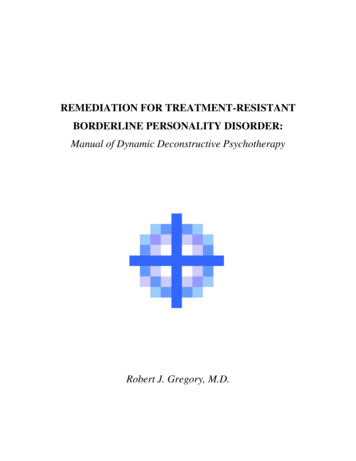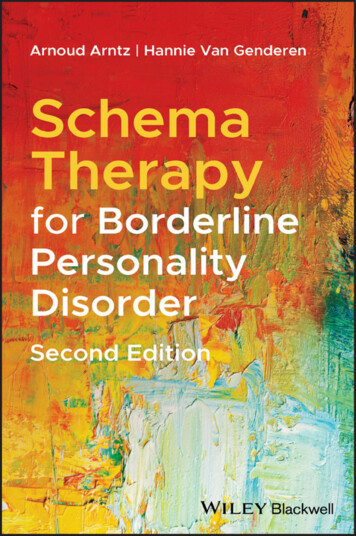
Transcription
Schema Therapy for BorderlinePersonality Disorder
Schema Therapy for BorderlinePersonality DisorderSecond EditionARNOUD ARNTZDepartment of Clinical Psychology,University of Amsterdam,The NetherlandsHANNIE VAN GENDERENMaastricht,The Netherlands
This edition first published 2021 2021 John Wiley & Sons LtdEdition HistoryJohn Wiley & Sons, Ltd (1e, 2009)All rights reserved. No part of this publication may be reproduced, stored in a retrieval system, ortransmitted, in any form or by any means, electronic, mechanical, photocopying, recording orotherwise, except as permitted by law. Advice on how to obtain permission to reuse material from thistitle is available at http://www.wiley.com/go/permissions.The right of Arnoud Arntz and Hannie van Genderen to be identified as the authors of the editorialmaterial in this work has been asserted in accordance with law.Registered Office(s)John Wiley & Sons, Inc., 111 River Street, Hoboken, NJ 07030, USAJohn Wiley & Sons Ltd, The Atrium, Southern Gate, Chichester, West Sussex, PO19 8SQ, UKEditorial Office111 River Street, Hoboken, NJ 07030, USAFor details of our global editorial offices, customer services, and more information about Wileyproducts visit us at www.wiley.com.Wiley also publishes its books in a variety of electronic formats and by print‐on‐demand. Some contentthat appears in standard print versions of this book may not be available in other formats.Limit of Liability/Disclaimer of WarrantyWhile the publisher and authors have used their best efforts in preparing this work, they make norepresentations or warranties with respect to the accuracy or completeness of the contents of this workand specifically disclaim all warranties, including without limitation any implied warranties ofmerchantability or fitness for a particular purpose. No warranty may be created or extended by salesrepresentatives, written sales materials or promotional statements for this work. The fact that anorganization, website, or product is referred to in this work as a citation and/or potential source offurther information does not mean that the publisher and authors endorse the information or servicesthe organization, website, or product may provide or recommendations it may make. This work is soldwith the understanding that the publisher is not engaged in rendering professional services. The adviceand strategies contained herein may not be suitable for your situation. You should consult with aspecialist where appropriate. Further, readers should be aware that websites listed in this work may havechanged or disappeared between when this work was written and when it is read. Neither the publishernor authors shall be liable for any loss of profit or any other commercial damages, including but notlimited to special, incidental, consequential, or other damages.Library of Congress Cataloging‐in‐Publication DataNames: Arntz, Arnoud, author. Genderen, Hannie van, author.Title: Schema therapy for borderline personality disorder / edited byArnoud Arntz, Hannie van Genderen.Other titles: Schematherapie bij tion: Second edition. Hoboken, NJ : Wiley-Blackwell, [2021] Includes bibliographical references and index.Identifiers: LCCN 2020006598 (print) LCCN 2020006599 (ebook) ISBN9781119101048 (cloth) ISBN 9781119101062 (paperback) ISBN9781119101147 (adobe pdf) ISBN 9781119101178 (epub)Subjects: LCSH: Borderline personality disorder–Treatment. Schema-focused cognitive therapy.Classification: LCC RC569.5.B67 A76 2020 (print) LCC RC569.5.B67(ebook) DDC 616.85/852–dc23LC record available at https://lccn.loc.gov/2020006598LC ebook record available at https://lccn.loc.gov/2020006599Cover Design: WileyCover Image: Ekely / Getty ImagesSet in 10.5/13pt Minion by SPi Global, Pondicherry, India10987654321
ContentsAbout the Authors viiPreface ixAcknowledgments xiIntroduction 11 Borderline Personality Disorder 32 Schema Therapy for Borderline Personality Disorder 73 Treatment 314 The Therapeutic Relationship 495 Experiential Techniques 696 Cognitive Techniques 1337 Behavioral Techniques 1498 Specific Methods and Techniques 1559 Methods per Mode 16710 Schema Therapy in Other Settings and Modalities 20111 Final Phase of Therapy 22512 Conclusion 229
viContentsAppendix A: Brochure for Patients: SchemaTherapy for People with Borderline PersonalityDisorder 233Appendix B: Cognitive Diary for Modes 239Appendix C: Positive Logbook 241Appendix D: Historical Testing 243Appendix E: Experiments 245Appendix F: Homework Form 247Appendix G: Problem Solving 249Appendix H: Changing Behavioral Patterns 251Appendix I: Eighteen Schemas 253Appendix J: Coping Strategies 259Appendix K: Form for the Historical Role Play 261References 263Index 271
About the AuthorsBetween 1987 and 2014 Arnoud Arntz (Professor of Clinical Psychologyand Experimental Psychopathology at Maastricht University and clinicalpsychologist) and Hannie van Genderen MPhil, (clinical psychologist, psychotherapist, and Supervisor of the International Society of SchemaTherapy (ISST) and the Dutch Association for Behavioral and CognitiveTherapy) worked together at the Riagg Maastricht. They were involvedthere in numerous studies in the field of anxiety disorders and personalitydisorders. Arnoud Arntz was project leader of the Dutch multi‐center trialcomparing schema therapy with transference‐focused psychotherapy. Oneof his main research interests is borderline personality disorder.Since 2014, Arnoud Arntz has been Professor of Clinical Psychology atthe University of Amsterdam. He is, together with Joan Farrell, PrincipalInvestigator of the international trial comparing two forms of group schematherapy for borderline to each other and to optimal treatment as usual. Hepractices as a clinical psychologist at the PsyQ mental health center inAmsterdam.Hannie van Genderen has worked since 2016 as a clinical psychologist inher own private practice. Since 2000 she has been the Director of“Schematherapieopeidingen” a Dutch Institute for Schema Therapy thatorganizes standard and advanced level international certification trainingprograms in schema therapy (individual for adults, children and adolescents,and group therapy). In addition to training in schema therapy for borderlinepersonality disorder, specialized training courses on Cluster C, workshopson Imagery Rescripting, Chairwork, Angry Modes, Depression, TheHealthy Adult, and Narcissitic Personality Disorder are offered (see www.schematherapieopleidingen.nl).
PrefaceSchema therapy is a relatively new integrative psychotherapy based on cognitive models and offers an effective treatment of borderline personalitydisorder (BPD). Several trials have now documented its effectiveness andcost‐effectiveness compared to psychodynamic treatment and treatment asusual. Moreover, dropout from treatment is consistently low, indicating thatschema therapy is well accepted by patients.This book offers a practical guide for therapists to conduct schema therapy with BPD patients. Building upon Jeffrey Young’s schema mode model,Young’s schema therapy, and insights from Beckian cognitive therapy andexperiential methods, it offers a conceptual model of BPD, a treatmentmodel, and a wealth of methods and techniques for treating BPD patients.The treatment not only addresses the DSM BPD criteria‐related problems,but also the psychopathological personality features underlying the symptoms, like attachment problems, punitive conscience, inadequately processed childhood traumas and so on. Research has demonstrated thatpatients improve in all these aspects, including on the level of automaticinformation processing.The authors equate their treatment to blind simultaneous chess playing ina pinball machine, meaning that the therapist has to be actively aware of theabundance of quickly changing factors that play a role in the patient’s problems, and simultaneously has to address them. Though treatment of BPD iscomplicated, many therapists can learn this method. Experienced therapistswith good stamina will feel supported and stimulated by the book’s practicalexplanations and examples. Central in the therapeutic relationship is theconcept of “limited reparenting,” which forms the basis for a warm and collaborative relationship. A good therapeutic relationship is not enough,however. Therefore, numerous experiential, interpersonal, cognitive andbehavioral methods and techniques are described that are specifically suited
xPrefacefor the treatment of BPD patients. Finally, the book offers specific methodsto be used in the treatment of very difficult cases and helps the therapist todeal with the many pitfalls that can arise from the treatment of BPD.Since the publication of the first edition of this book in 2009 severalimportant developments took place in schema therapy. Moreover, fromteaching schema therapy we learned about bottlenecks that participantsencountered in applying the treatment. We also realized that the generalapproach and the techniques change throughout the different stages oftherapy. This necessitated a thorough revision. In this new edition we haverevised the text so that new insights and methods are integrated. Thisrevised approach leads to a speeding up of treatment, without loss of effectiveness. The new edition describes how techniques should be adapted tothe phase of therapy. We also discuss new approaches related to the application of schema therapy in groups, couples, and youths. The latest researchfindings and their implications for clinical practice are discussed, and thetheoretical underpinnings of the schema mode model are now more extensively covered. We treat more schema modes now, as many patients presentwith additional modes than covered by the basic mode model of BPD, andthe clinician should know how to handle these. Lastly, we now refer to fragments of the audiovisual production “step by step” illustrating the differenttechniques.
AcknowledgmentsThe writing of a book combined with a busy job at the Maastricht CommunityMental Health Centre demanded much time, which I managed to findthanks to the unconditional support of my late husband Leo Scheffer. He notonly took over much of the care of the family but also helped me with reading and typing out the texts. I thank my children Sacha and Zoë for theirpatience as they heard “not now” many times during this period.I learned the treatment of patients with personality disorders thanks tothe many training opportunities organized by Arnoud Arntz fromMaastricht University, by inviting, among others, Tim Beck, Cory Newman,Jeffrey Young, Christine Padesky, Kathleen Mooney, Joan Farrell and IdaShaw. However, I especially learned a great deal from Arnoud himself,through his enthusiasm and assertiveness in continuously discovering newways to treat “untreatable” patients, just like the ones with borderline personality disorder.I would like to thank my colleagues from RIAGG Maastricht, particularly Arnoud Arntz, Tonny van Gisbergen and Wiesette Krol from theBorderline peer supervision group, for their collaboration and supportwhile learning to treat patients with borderline personality disorder. MarjonNadort, Marleen Rijkeboer and Remco van der Wijngaart I want to thankfor years of collaboration: with them I have given the majority of coursesand workshops. Together we have always found better ways to teach schematherapy to colleagues.I am also indebted to my colleagues Monique Wijers, Monique Auerbach,Ina Krijgsman and my brother‐in‐law Igor van de Wal as they have read thewhole book, asked wise questions and suggested additions.The patients I have treated may have contributed most to this book.Examples in this book are (anonymously) taken from our conversations,
xiiAcknowledgmentsand I have learned a lot from them. The diagnosis of borderline personalitydisorder is unfortunately not yet accepted to the extent that I could list theirnames here. But my heartfelt thanks to you.Hannie van GenderenWithout my teachers, one of them the co‐author of this book, I should havenever reached the point of treating people with borderline personality disorder. I am very grateful for this. I would like to give my special thanksto Tim Beck, Christine Padesky, Kathleen Mooney, Cory Newman, JoanFarrell, and Ida Shaw, and particularly Jeffrey Young for what they taughtour team in their workshops. Jeffrey Young in particular deserves mythanks, as he developed a model that not only matched with my own earlythinking about borderline personality disorder, but also developed a comprehensive treatment, which is the subject of this book. My therapistand research colleagues, among whom are my former PhD candidatesLaura Dreessen, Anoek Weertman, Simkje Sieswerda, Joos Bloo, Thea vanAsselt, Marjon Nadort, Lotte Bamelis and Jill Lobbestael, I also want tothank for the help they provided with developing the treatments and theresearch into borderline personality disorder. Moreover, I would like tothank the research assistants and interns who have conducted many s tudies,and especially the patients who have taken part in the treatment and theresearch, without whom we could not have gained insight into these complex problems and their treatment.Ultimately, this book could not have come about without the opportunitiesoffered by the Maastricht Community Mental Health Centre to the academicproject of the Research Institute of Experimental Psychopathology of theMaastricht University, as well as the grants from the Dutch National Fund forMental Health and the Fund for Developmental Medicine by the College forCare Insurances. Their grants enabled the training of the therapists for themulti‐center trial into treatments of borderline personality disorder and theconducting of this study, which empirically tested the effectiveness and cost‐effectiveness of the treatment outlined in this book.Thanks are due to Kyra Sendt and Jolijn Drost for their help with translating the original Dutch book into the first English edition.Arnoud Arntz
IntroductionUntil recently, patients with borderline personality disorder (BPD) wereknown as particularly difficult patients. They were viewed as patients whoeither could not be helped by therapy or, in the best‐case scenario, showedlow success rates to treatment. Meanwhile, their demands on both medicaland mental health care are great and their dropout rates from treatmentprograms are high.In this book we describe a treatment for patients with BPD, which, inmost cases, leads to recovery from this disorder or substantial clinicalimprovement. Schema therapy (ST) not only leads to a reduction in BPDsymptoms, but also to lasting changes in the patient’s personality.In Chapter 1, BPD is defined and described, followed by a discussion ofthe development of this disorder.Chapter 2 gives an explanation of ST for BPD, developed by JeffreyYoung. The treatment is based on the schema mode model. The differentschema modes for patients with BPD are described in this chapter.In Chapter 3 we explain the aims and different phases of the therapy.Chapters 4–8 discuss different treatment methods and techniques.Chapter 4 involves seeing the therapeutic relationship as an instrument ofchange. Also the essential concept of “limited reparenting,” a central pointof ST, is discussed at length.Schema Therapy for Borderline Personality Disorder, Second Edition.Arnoud Arntz and Hannie van Genderen. 2021 John Wiley & Sons Ltd. Published 2021 by John Wiley & Sons Ltd.
2Schema Therapy for Borderline Personality DisorderChapter 5 describes experiential techniques that use experiencing to bringabout change. These techniques are: imagery rescripting; role playing; thetwo‐or‐more‐chair technique; and experiencing and expressing feelings.The cognitive techniques used in this book are described and explainedin Chapter 6. As there is a great deal of literature about these techniques,they are only briefly defined. This is also the case for the behavioral techniques described in Chapter 7.Chapter 8 deals with a number of specific therapeutic methods andtechniques. While these are not relevant for all BPD patients, they can beimportant and useful for specific patients and applications.Chapter 9 explains which techniques are the most appropriate to eachschema mode. The art of addressing different modes in a single session isalso discussed in this chapter.The latest developments in the field of ST are explained in Chapter 10. Inparticular, Group‐ST, and ST with couples where one of the two partnershas BPD, are discussed. We also briefly discuss the application of ST in daytreatment and inpatient settings, the use of nonverbal therapies as adjunctto ST, and the application of ST for children and youths, and older people.Chapter 11 deals with the final phase of therapy during which the patientno longer has BPD, but perhaps retains some of the personality characteristicsand/or coping strategies, which could stand in the way of further positivechanges.Chapter 12 contains the summary and conclusion.Considering that a large percentage of BPD patients are female, the authorsrefer to the patient in the feminine form. Although many therapists are female,for the sake of clarity the authors refer to the therapist using the masculineform.
1Borderline Personality DisorderWhat Is Borderline Personality Disorder?Patients with borderline personality disorder (BPD) have problems withalmost every aspect of their lives. They have problems with constantlychanging moods, their relationships with others, unclear identities, andimpulsive behaviors. Outbursts of rage and crises are commonplace. Despitethe fact that many BPD patients are intelligent and creative, they seldomsucceed in developing their talents. Often their education is incomplete,and they remain unemployed. If they work, it is often at a level far belowtheir capabilities. They are at a great risk of self‐harm by means of self‐injury and/or substance abuse. The suicide risk is high and approximately10% die as a result of a suicide attempt (Paris, 1993).In this book, the DSM‐5 diagnostic criteria for BPD are used for the diagnosis of BPD and not the psychoanalytical definition of the borderline personality organization (Kernberg, 1976, 1996; Kernberg, Selzer, Koenigsberg,Carr, & Applebaum, 1989). The borderline personality organization includesa number of personality disorders and axis‐I disorders and is therefore fartoo extensive for the specific treatment for BPD that will be described here.According to the DSM‐5, patients must satisfy at least five of the nine criteria, as listed in Table 1.1, to obtain a diagnosis of BPD. The essential generalfeature of the DSM‐5 definition of BPD is instability and its influence on theareas of interpersonal relationships, self‐image, feelings, and impulsiveness.Schema Therapy for Borderline Personality Disorder, Second Edition.Arnoud Arntz and Hannie van Genderen. 2021 John Wiley & Sons Ltd. Published 2021 by John Wiley & Sons Ltd.
4Table 1.1Schema Therapy for Borderline Personality DisorderDSM‐5 diagnostic criteria for borderline personality disorderA pervasive pattern of instability of interpersonal relationships, self‐image, andaffects, and marked impulsivity, beginning by early adulthood and present in avariety of contexts, as indicated by five (or more) of the following:1. Frantic efforts to avoid real or imagined abandonment. (Note: Do not includesuicidal or self‐mutilating behavior covered in criterion 5.)2. A pattern of unstable and intense interpersonal relationships characterized byalternating between extremes of idealization and devaluation.3. Identity disturbance: markedly and persistently unstable self‐image or sense of self.4. Impulsivity in at least two areas that are potentially self‐damaging (e.g.,spending, sex, substance abuse, reckless driving, binge eating). (Note: Do notinclude suicidal or self‐mutilating behavior as covered in criterion 5.)5. Recurrent suicidal behavior, gestures or threats, or self‐mutilating behavior.6. Affective instability due to a marked reactivity of mood (e.g., intense episodicdysphoria, irritability or anxiety usually lasting a few hours and only rarelymore than a few days).7. Chronic feelings of emptiness.8. Inappropriate, intense anger or difficulty controlling anger (e.g., frequentdisplays of temper, constant anger, recurrent physical fights).9. Transient, stress‐related paranoid suicidal ideation or severe dissociative symptoms.Source: After: American Psychiatric Association (APA, 2013) DSM‐5.Prevalence and ComorbidityBPD is one of the most common mental disorders within the (outpatientand inpatient) clinical population. Prevalence in the general population isestimated at 1.1–2.5% and varies in clinical populations depending on thesetting, from 10% of the outpatients up to 20–50% of inpatients. However,in many cases the diagnosis of BPD is made late or not given at all. Thismight be due to the high comorbidity and other problems associated withBPD, which complicate the diagnostic process.The comorbidity in this group of patients is high and diverse. On axis‐I,there is often depression, eating disorders, social phobia, PTSD, or relationship problems. In fact one can expect any or all of these disorders in strongeror weaker forms along with BPD.All of the personality disorders can be co‐morbid to BPD. A commoncombination is that of BPD along with avoidant, dependent, narcissistic,antisocial, histrionic, and paranoid disorders (Layden, Newman, Freeman,& Morse, 1993).
Borderline Personality Disorder5Reviews and studies by Dreessen and Arntz (1998), Mulder (2002), andWeertman, Arntz, Schouten, and Dreessen (2005) have shown that anxietyand mood disorders are treatable when the patient has a comorbidity witha personality disorder. However, in the case of BPD, one must be careful toonly treat the axis‐I disorder. BPD is a serious disorder that results in permanent disturbance of the patient’s life with numerous crises and suicideattempts, which makes the usual treatment of axis‐I disorders burdensome.Axis‐I complaints and symptoms often change in nature and scope, makingthe diagnostic process even more difficult. This often results in the treatingof BPD taking priority. Disorders that should take priority over BPD intreatment are described in “(Contra‐) Indications” (see Chapter 2).Development of BPDThe majority of patients with BPD have experienced sexual, physical, and/oremotional abuse, and emotional neglect in their childhood; sexual abuse inparticular between the ages of 6 and 12 (Herman, Perry, & van der Kolk,1989; Hernandez, Arntz, Gaviria, Labad, & Gutiérrez‐Zotes, 2012;Lobbestael, Arntz, & Bernstein, 2010; Ogata et al., 1990; Weaver & Clum,1993). It is more problematic to identify emotional abuse and neglect in BPDpatients than to identify sexual or physical abuse. Emotional abuse andneglect often remains hidden or not acknowledged by the BPD patient outof a sense of loyalty toward the parents or due to a lack of knowledge of whata normal, healthy childhood involves. These patients don’t know what theymissed, because they never experienced feelings of being loved, accepted,and cared for. When someone tries to give them love and acceptance later inlife, they sometimes react negatively toward that person (i.e., the therapist).These traumatic experiences in combination with temperament, i nsecureattachment, developmental stage of the child, as well as the social situationin which things took place, result in the development of dysfunctionalinterpretations of the patient’s self and others (Arntz, Weertman, & Salet,2011; Zanarini, 2000). Patients with BPD have a disorganized attachmentstyle. This is the result of the unsolvable situation they experienced as achild, in which their parent was both a menace or threat, as well as a potential safe haven (van IJzendoorn, Schuengel, & Bakermans‐Kranenburg,1999). Translated into cognitive terms, a combination of dysfunctionalschemas and coping strategies results in BPD (e.g., Arntz et al., 2011).Patients with BPD have a very serious and complex set of problems.Because the patient’s behavior is so unpredictable, it exhausts the sympathy
6Schema Therapy for Borderline Personality Disorderand endurance of family and friends. Life is not only difficult for thepatients, but also for those around them. At times, life is so difficult that thepatient gives up (suicide) or her support system gives up and breaks offcontact with the patient. Treating BPD patients is often also fatiguing forthe mental health care giver, especially in the absence of effective treatmentmethods. The good news is that effective treatments have been developedthe last decades, and schema therapy is one of the most successful.Schema therapy offers BPD patients and therapists a treatment model inwhich the patient is helped to break through the dysfunctional patterns shehas created and to achieve a healthier life. The model helps patients andtherapists to understand how early childhood experiences are related to thepresent problems and offers grip on the otherwise overwhelming and difficult to understand problems. Treating BPD patients with schema therapymakes it relatively easy to comprehend the patient’s dysfunctional behaviorand it gives the therapist many tools to treat the patient.
2Schema Therapy for BorderlinePersonality DisorderThe Development of Schema Therapy for BorderlinePersonality DisorderBefore the development of specialized psychotherapies for BPD, such asschema therapy (ST), BPD was treated primarily from a psychoanalyticalperspective. This started to change in the late 1980s when cognitive behaviorists began to study the treatment of personality disorders with cognitivebehavioral therapy, and psychodynamic therapists started to develop variantsof psychodynamic therapy that were specifically adapted to BPD.The most important early developments in specialized psychotherapies forBPD that emerged in this era were the formulation and empirical validationof Dialectical Behavior Therapy (DBT; Linehan, Armstrong, Suarez, Allmon,& Heard, 1991; Linehan, 1993), the development of Transference‐FocusedPsychotherapy (TFP) (Kernberg, Selzer, Koenigsberg, Carr, & Applebaum,1989), the development of Mentalization Based Treatment (MBT, Bateman &Fonagy, 2004), and the development of cognitive therapy for personality disorders. The use of cognitive therapy for treating personality disorders wasfirst introduced by Aaron Beck, Arthur Freeman, and colleagues in theirwork Cognitive Therapy of Personality Disorders (1990). In that same year,Jeffrey Young introduced a new form of cognitive therapy, which he referredto as “Schema‐Focused Therapy,” later “Schema Therapy” (Young, 1990,1994). He later expanded upon this therapeutic model with the introductionSchema Therapy for Borderline Personality Disorder, Second Edition.Arnoud Arntz and Hannie van Genderen. 2021 John Wiley & Sons Ltd. Published 2021 by John Wiley & Sons Ltd.
8Schema Therapy for Borderline Personality Disorderof schema modes (Young, Klosko, & Weishaar, 2003). His theory is basedupon a combination of insights derived from cognitive, behavioral, psychodynamic, humanistic, and developmental (including attachment) theories.The actual treatment is mainly based on cognitive behavioral therapy andtechniques derived from experiential therapies. There is a strong emphasis onthe therapeutic relationship which is used as a means to bring about change,as well as on the emotional processing of traumatic experiences.To date, ST appears to be a good method to achieve substantial personality improvements in BPD patients.Research ResultsResearch on traditional psychoanalytical forms of treatment showed highdropout percentages (46–67%) and a relatively high percentage of suicide.Across four longitudinal studies, approximately 10% of the patients diedduring treatment or within 15 years following treatment due to suicide(Paris, 1993). This percentage is comparable to that of nonpsychotherapeutically treated BPD patients (8–9%: as reported by Adams, Bernat, &Luscher, 2001).The first controlled study of cognitive behavioral treatment for BPD wasrealized by Linehan et al. (1991). The DBT they introduced had lower dropout rates, fewer hospitalizations, and a greater reduction in self‐injury andsuicidal behavior in comparison with usual treatment. On other measurements of psychopathology, there were no significant differences when compared with usual treatment. Uncontrolled studies as to the effectiveness ofBeck’s cognitive therapy also showed a reduction in suicide risk and depressive symptoms, as well as a decrease in the number of BPD symptoms(Arntz, 1999; Beck, 2002; Brown, Newman, Charlesworth, Crits‐Christoph,& Beck, 2004). Moreover, the dropout rates during the first year were lowerthan normal (about 9%).The first controlled study testing ST as developed by Young was conductedin the Netherlands, where ST was compared to TFP, a psychodynamic methodfrom Kernberg and co‐workers (Giesen‐Bloo et al., 2006). This study startedin 2000 and involved 3 years of treatment. ST showed more positive resultsthan TFP in reduction of BPD symptoms, as well as other aspects of psychopathology and quality of life. In the follow‐up study, 4 years after the start ofthe treatment, 52% of the patients who started ST recovered from BPD, compared to 29% in TFP, while more than two‐thirds of ST participants showed
Schema Therapy for Borderline Personality Disorder9clinically significant improvement in reducing BPD symptoms, compared to52% in TFP. These percentages are impressive given that dropouts (eventhose due to somatic illness) were included in the study.One of the most compelling results from this first randomized clinicaltrial (RCT) was that all BPD problems were reduced and not only conspicuous symptoms such as self‐harm. For instance, the patie
Title: Schema therapy for borderline personality disorder / edited by Arnoud Arntz, Hannie van Genderen. Other titles: Schematherapie bij borderline-persoonlijkheidsstoornis. . 2 Schema Therapy for Borderline Personality Disorder 7 3 Treatment 31 4 The Therapeutic Relationship 49 5 Experiential Techniques 69
